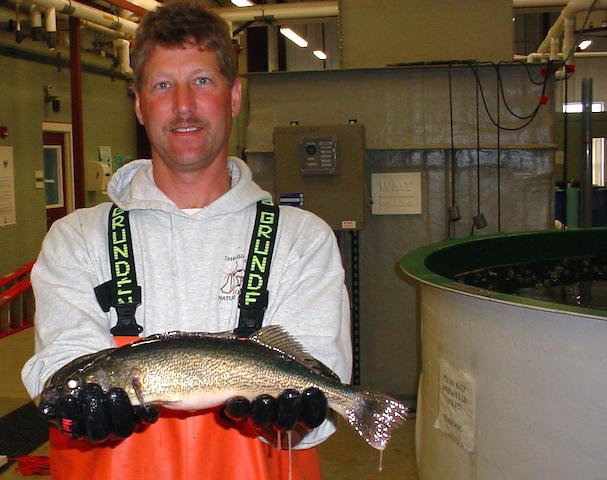
Profitable commercial production for walleye and saugeye
September 8, 2015
By Linda Hiemstra
 Research on methods for raising walleye and hybrid walleye (saugeye) utilizing indoor larval fry systems for initial rearing and heated recirculating aquaculture systems (RAS) for grow-out
Research on methods for raising walleye and hybrid walleye (saugeye) utilizing indoor larval fry systems for initial rearing and heated recirculating aquaculture systems (RAS) for grow-outWith use of a combination of old and new technologies, University of Wisconsin Stevens Point-Northern Aquaculture Demonstration Facility team have shown it is possible to raise large walleye and hybrid walleye in a single growing season.
Walleye have been raised for many years by both private and public sectors, mainly in outdoor pond type systems. New technologies are now being utilized to raise these fish to a much larger size in a shorter time. Indoor larval tank rearing systems have been demonstrated in Iowa for many years and now UWSP-NADF is using heated recycled water systems for grow out.
Growing walleye indoors allows the hatchery or fish farm to control environmental conditions such as water temperature, dissolved oxygen and other water quality parameters resulting in an ideal setting to grow fish quickly. Another point of focus is to eliminate the need for expensive “pinhead” minnow forage for advanced grow-out of walleye fingerlings that one would commonly see in outdoor pond settings. The pinhead forage cost can be as much as 50% of the entire forage cost for larger extended growth walleyes that are wanted by many natural resource agencies for stocking purposes. There is potential for the commercial use of these new technologies, especially in the Midwest, to produce walleye for both stocking and food fish.
Since 2008, UWSP-NADF, along with collaborators and partners from many agencies and venues, has been researching methods to effectively raise walleye and hybrid walleye (saugeye) utilizing indoor larval fry systems for initial rearing and heated recirculating aquaculture systems (RAS) for grow-out.
The facility has been able to intensively grow walleye and sauger to maturity and to create a broodstock which have been successfully spawned during normal and out- of- season spawning from February–June (normal spawning timeframe in Wisconsin for walleye is April). Walleye and hybrid walleye eggs have been successfully incubated, hatched and larvae were feed trained and raised to market size in RAS on commercial diets. No brine shrimp, zooplankton or other natural feeds are utilized. Success rates of up to 60% for the first 30 day larval rearing period have been achieved with the correct tank setups.
Cannibalism is normal for this species and special measures, such as grading, must be taken to limit this in each individual tank. Survival rates increase greatly as fish become larger with the final grow out survival as high as 95%. Hybrid and purebred walleye were raised to market size (454 g) within 12 months with the RAS technology and new larval rearing methods.
Large size and fast growth is crucial for production and industry collaborators indicate great market acceptance, as well as good profit potential for walleye and hybrid walleye.
UWSP-NADF is one of the few facilities in the US with an intensively reared, feed trained broodstock of walleye and sauger. These broodstock remain at the facility in a warm water RAS (18-24°C) and have been successfully spawned out-of-season using standard photoperiod and temperature manipulation methodology.
UWSP-NADF has been partnering with a private Wisconsin business, Northside Enterprises Inc, as part of a Small Business Innovative Research Grant (SBIR) to advance the technology of rearing walleye and hybrid walleye intensively for both food and stocking purposes. UWSP- NADF was also awarded a SBIR Advance Matching Grant to develop and accelerate the commercialization of these new innovative aquaculture technologies.
These projects are meant to demonstrate the feasibility of increasing the production of advanced walleye fingerlings for stocking recreational sport fisheries and also show the increased profitability and ability with one or more integrated systems in raising hybrid walleye from fry to market size in one growing season.
Technology transfer from these projects will include workshops, tutorials, videos, and walleye and hybrid culture manuals for intensively reared walleye and hybrids. UWSP-NADF is already working directly with several Wisconsin aquaculture farms to assist in walleye and hybrid production using these new technologies.
It is fully expected that these studies will demonstrate that the break-even costs of walleye and hybrid walleye production will be significantly lower than current market prices for this product, therefore allowing for profitable commercial production.
This project will provide information to appropriate end user groups leading to the expansion of aquaculture production and profitability while also allowing private growers to explore a potential new species without significant cash or equipment outlay.
More information on this research and other projects can be found at aquaculture.uwsp.edu or by request from Emma Wiermaa, Outreach Specialist, ewiermaa@uwsp.edu.





